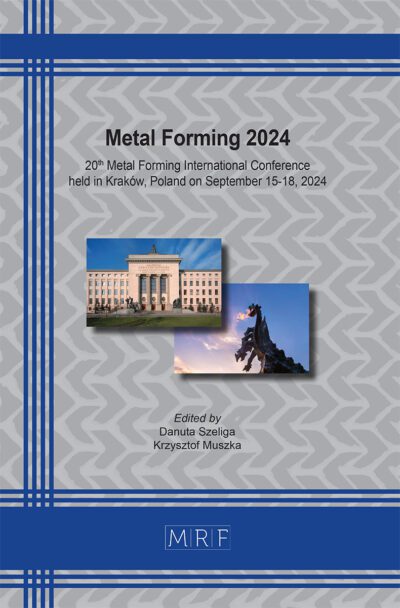Out-of-plane shear testing of anisotropic sheet metals using double bridge shear test
Bojan STARMAN, Andraž MAČEK, Tomaž PEPELNJAK, Miroslav HALILOVIČ, Sam COPPIETERS
Abstract. The paper presents a novel experimental and numerical methodology for calibration of out-of-plane shear behaviour of moderate thick sheet metals by double bridge shear test. By conducting tests, it is shown that shear response of sheet metal in all three principal material planes can be characterised by the same specimen design with the shear detail or material oriented in a specific direction. For a 2.4 mm thick AA5754-H22 sheet material it is shown that the shear response is the highest in the rolling-transverse (RD-TD) plane, followed by the transverse-normal (TD-ND) plane, and the lowest in the rolling-normal (RD-ND) plane.
Keywords
Shear Testing, Plastic Anisotropy, Digital Image Correlation, YLD2004-18p
Published online 5/7/2025, 8 pages
Copyright © 2025 by the author(s)
Published under license by Materials Research Forum LLC., Millersville PA, USA
Citation: Bojan STARMAN, Andraž MAČEK, Tomaž PEPELNJAK, Miroslav HALILOVIČ, Sam COPPIETERS, Out-of-plane shear testing of anisotropic sheet metals using double bridge shear test, Materials Research Proceedings, Vol. 54, pp 1520-1527, 2025
DOI: https://doi.org/10.21741/9781644903599-164
The article was published as article 164 of the book Material Forming
![]() Content from this work may be used under the terms of the Creative Commons Attribution 3.0 license. Any further distribution of this work must maintain attribution to the author(s) and the title of the work, journal citation and DOI.
Content from this work may be used under the terms of the Creative Commons Attribution 3.0 license. Any further distribution of this work must maintain attribution to the author(s) and the title of the work, journal citation and DOI.
References
[1] F. Barlat, J. W. Yoon, and O. Cazacu, “On linear transformations of stress tensors for the description of plastic anisotropy,” Int. J. Plast., vol. 23, no. 5, pp. 876–896, May 2007. https://doi.org/10.1016/j.ijplas.2006.10.001.
[2] B. Zillmann, T. Clausmeyer, S. Bargmann, T. Lampke, M.-X. Wagner, and T. Halle, “Validation of simple shear tests for parameter identification considering the evolution of plastic anisotropy,” Tech. Mech.-Eur. J. Eng. Mech., vol. 32, no. 2–5, pp. 622–630, 2012.
[3] G. Han, J. He, and S. Li, “Simple shear deformation of sheet metals: finite strain perturbation analysis and high-resolution quasi-in-situ strain measurement,” Int. J. Plast., vol. 150, p. 103194, Mar. 2022. https://doi.org/10.1016/j.ijplas.2021.103194.
[4] B. Starman, T. Pepelnjak, A. Maček, M. Halilovič, and S. Coppieters, “Inverse calibration of out-of-plane shear anisotropy parameters of sheet metal,” Int. J. Solids Struct., vol. 313, p. 113313, May 2025. https://doi.org/10.1016/j.ijsolstr.2025.113313.
[5] ISO, “ISO 6892-1:2019(en), Metallic materials — Tensile testing — Part 1: Method of test at room temperature.” Accessed: Sep. 15, 2020. [Online]. Available: https://www.iso.org/obp/ui#iso:std:iso:6892:-1:ed-3:v1:en
[6] J. R. Davis, Tensile Testing, 2nd ed. Materials Park OH: ASM International, 2004.
[7] A. Maček, B. Starman, N. Mole, and M. Halilovič, “Calibration of Advanced Yield Criteria Using Uniaxial and Heterogeneous Tensile Test Data,” Metals, vol. 10, no. 4, p. 542, Apr. 2020. https://doi.org/10.3390/met10040542.
[8] International Organization for Standardization, “ISO 16808 – Determination of biaxial stress-strain curve by means of bulge test with optical measuring system.” 2013.
[9] S. Suttner and M. Merklein, “Experimental and numerical investigation of a strain rate controlled hydraulic bulge test of sheet metal,” J. Mater. Process. Technol., vol. 235, pp. 121–133, Sep. 2016. https://doi.org/10.1016/j.jmatprotec.2016.04.022.
[10] B. Chen, B. Starman, M. Halilovič, L. A. Berglund, and S. Coppieters, “Finite Element Model Updating for Material Model Calibration: A Review and Guide to Practice,” Arch. Comput. Methods Eng., Nov. 2024. https://doi.org/10.1007/s11831-024-10200-9.
[11] B. ASTM Standard, “Standard Test Method for Shear Testing of Thin Aluminum Alloy Products,” 2005.













